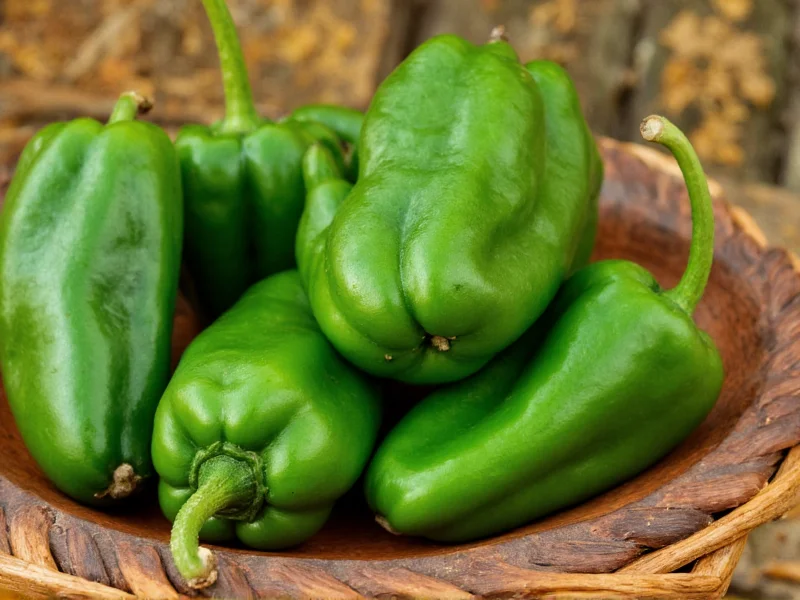Understanding where poblano peppers fall on the Scoville scale helps home cooks and culinary professionals make informed decisions about spice levels in their recipes. The Scoville scale, developed by pharmacist Wilbur Scoville in 1912, measures the concentration of capsaicin—the compound responsible for a pepper's heat—in Scoville Heat Units (SHU). This standardized measurement allows for consistent comparison between different chili varieties.
Understanding Poblano Pepper Heat Levels
Poblano peppers, scientifically known as Capsicum annuum, typically register between 1,000 and 2,000 SHU on the Scoville scale. This places them firmly in the mild category, though their heat can vary based on growing conditions, maturity, and individual plant genetics. When dried, poblanos become ancho peppers, which maintain a similar heat profile but develop richer, fruitier flavors.
Several factors influence poblano heat levels:
- Growing conditions: Stressors like inconsistent watering or extreme temperatures can increase capsaicin production
- Ripeness: As poblanos mature from dark green to reddish-brown, their heat often intensifies slightly
- Seed and membrane content: The white ribs and seeds contain the highest concentration of capsaicin
- Individual variation: Even within the same plant, heat levels can differ between peppers
Pepper Heat Comparison Chart
| Pepper Variety | Scoville Heat Units (SHU) | Heat Level |
|---|---|---|
| Bell Pepper | 0 SHU | Mild |
| Poblano | 1,000-2,000 SHU | Mild to Medium |
| Guajillo | 2,500-5,000 SHU | Medium |
| Jalapeño | 2,500-8,000 SHU | Medium |
| Serrano | 10,000-23,000 SHU | Medium-Hot |
| Habanero | 100,000-350,000 SHU | Very Hot |
Culinary Applications of Poblano Peppers
The moderate heat level of poblano peppers makes them exceptionally versatile in cooking. Unlike hotter varieties that can dominate a dish, poblanos contribute subtle warmth while allowing other flavors to shine through. Their thick walls and rich, earthy flavor profile with notes of tobacco and raisin make them ideal for:
- Stuffed peppers (chiles rellenos): Their size and shape accommodate fillings while their mild heat won't overwhelm complementary ingredients
- Roasted pepper applications: Roasting enhances their natural sweetness and creates a smoky depth that works well in sauces, salsas, and soups
- Mole sauces: As a base ingredient in many traditional Mexican moles, poblanos provide foundational flavor without excessive heat
- Fresh applications: When used raw in salads or salsas, they add mild pepper flavor with minimal heat impact
Common Misconceptions About Poblano Heat
Several misconceptions persist about poblano peppers and their heat level. Many people mistakenly believe that all green chilies have similar heat profiles, but this isn't accurate. Poblanos are frequently confused with pasilla peppers (which are actually dried poblanos) or even Anaheim peppers, which have a similar appearance but slightly different heat range (500-2,500 SHU).
Another common misunderstanding is that larger poblanos are always milder. While size can sometimes correlate with maturity, heat levels depend more on growing conditions and genetics than physical size. Some home gardeners report significant heat variations between poblanos from the same plant, demonstrating the natural variability in chili pepper heat.
Substituting Poblanos in Recipes
When substituting for poblanos, consider both flavor profile and heat level. For authentic poblano flavor with similar mild heat, Anaheim peppers make the closest substitute. If you need slightly more heat while maintaining a similar flavor profile, consider using a combination of bell peppers and a small amount of jalapeño.
Chefs working with poblano scoville scale measurements should remember that removing seeds and membranes can reduce heat by up to 70%, as these parts contain the highest concentration of capsaicin. For those seeking poblano pepper heat level alternatives, cubanelle peppers (100-1,000 SHU) offer an even milder option, while New Mexico chilies (500-7,000 SHU) provide a similar flavor with potentially more heat.
Practical Tips for Handling Poblanos
When working with poblano peppers, roasting them over an open flame or under a broiler enhances their natural sweetness and creates a smoky flavor that complements their mild heat profile. After roasting, place them in a covered bowl for 10-15 minutes to steam, which makes peeling the skin easier.
For those concerned about poblano pepper spiciness, wearing gloves during preparation prevents capsaicin transfer to sensitive skin areas. If you accidentally touch your eyes or face after handling peppers, use milk or yogurt to neutralize the burning sensation rather than water, which can spread the capsaicin oil.
Frequently Asked Questions
Are poblano peppers considered hot?
Poblano peppers are classified as mild to medium heat on the Scoville scale, measuring between 1,000-2,000 SHU. They're significantly milder than jalapeños (2,500-8,000 SHU) and habaneros (100,000-350,000 SHU), making them accessible to most palates without overwhelming heat.
How does poblano heat compare to jalapeño?
Poblanos are generally milder than jalapeños. While poblanos measure 1,000-2,000 Scoville units, jalapeños range from 2,500-8,000 SHU. This means even the hottest poblano is typically milder than the mildest jalapeño, making poblanos a better choice for those sensitive to spice.
Why do some poblano peppers taste hotter than others?
Poblano heat varies due to growing conditions, maturity level, and individual plant genetics. Factors like inconsistent watering, temperature stress, and soil composition can increase capsaicin production. Additionally, the seeds and white membranes contain the highest concentration of heat compounds, so preparation method affects perceived spiciness.
Can I use poblano peppers if I don't like spicy food?
Yes, poblano peppers are an excellent choice for those who prefer mild heat. At 1,000-2,000 SHU, they're among the mildest chili varieties. Removing the seeds and membranes reduces heat further. Their rich, earthy flavor provides depth to dishes without overwhelming spice, making them suitable for most spice-sensitive palates.
What's the difference between fresh poblanos and dried anchos?
Fresh poblanos and dried anchos are the same pepper at different stages. When dried, poblanos become anchos, developing a deeper, fruitier flavor with notes of raisin and tobacco while maintaining a similar heat level (1,000-2,000 SHU). The drying process concentrates flavors but doesn't significantly increase heat.











 浙公网安备
33010002000092号
浙公网安备
33010002000092号 浙B2-20120091-4
浙B2-20120091-4